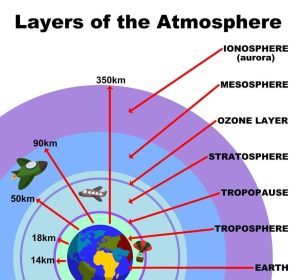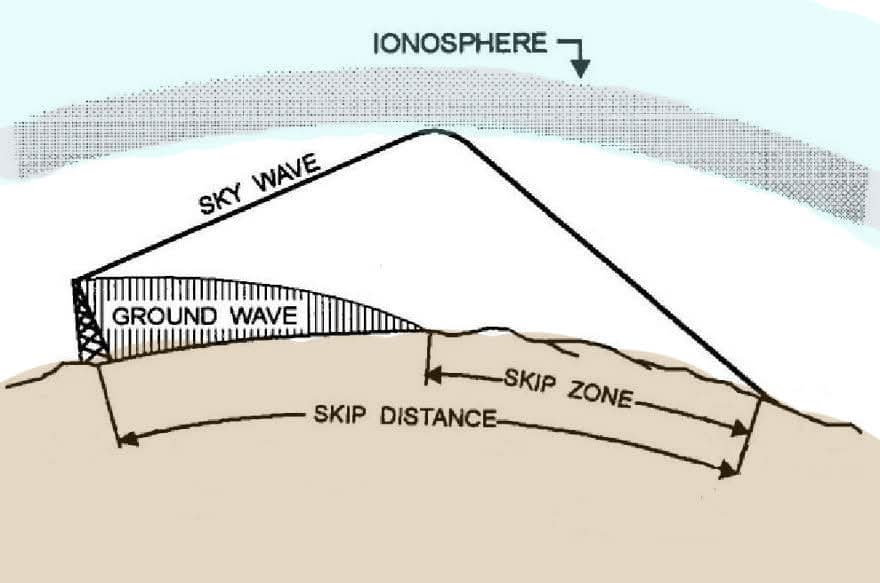Introduction to the Skywave, Ground Wave, Skip Distance and Skip Zone

How High Up is the Ionosphere? (source: https://sciencediagrams.com/atmosphere-layers/)
During our recent Field Weekend, we discussed with a new visitor how radio signals travel from one station to another.
Amateur radio operators can transmit at high frequencies (HF) ranging from 3 MHz to 30 MHz; the radio waves from these transmissions do not necessarily travel in a linear fashion, though.
In fact, while an RF signal can travel hundreds of kilometres from transmitter to receiver, a radio receiver placed on a certain portion of the RF’s voyage will not detect any signals from the originating transmission. Nothing! Silence! This area of the RF transmission is known as the skip zone.
Understanding such concepts as skip zones, skip distance, and sky/ground waves can help us choose the right frequency band and time of day to get the best circumstances for the purposes of our transmission.

Skywave, Ground Wave, Skip Zone and Skip Distance – Electronics Technician – Volume 7 – Figure 1-8 – Larry D. Simmons Floyd L. Ace II (Public domain)
The Earth’s Atmospheric Mirror: The Ionosphere
Let’s first talk about a natural phenomenon: the ionosphere.
Imagine a layer of our atmosphere high above the Earth (roughly 60 to 1,000 kilometres up) that’s filled with electrically charged particles, or ions. UV radiation from the sun creates these ions by knocking electrons free from atoms and molecules.
This knowledge is important for us amateur radio enthusiasts because the ionosphere acts like a giant, invisible mirror for certain radio frequencies!
Depending on the frequency of our signals and the conditions of the ionosphere (which change constantly with the sun’s activity, time of day, and season), radio waves can be refracted or bent back down to Earth. This bending is what allows us to communicate over vast distances, far beyond the visual horizon.
Two Main Paths: Ground Wave and Skywave
When we transmit from a radio, the RF signal may travel in a couple of primary ways:
- The Ground Wave: This is the radio signal that travels along the surface of the Earth. We might consider it a wave hugging the ground. Ground waves are most effective at lower frequencies, like those on the AM broadcast band or our 160m and 80m amateur radio bands. Ground waves are good for local communications, as they’re relatively stable and less affected by atmospheric conditions. However, because the ground absorbs some of the RF energy, ground waves’ range can be restricted, often to a few hundred miles at best, and occasionally much less depending on frequency and topography.
- The Skywave (or Ionospheric Propagation): This kind of transmission is where magic happens for long-distance communication. The skywave is the portion of our radio signal that travels upwards into the atmosphere, hits the ionosphere, and (hopefully) becomes refracted back down to Earth. This kind of transmission is how we can talk to someone on another continent. As mentioned, the effectiveness of skywave propagation depends heavily on the frequency being used and the current state of the ionosphere. Higher frequencies (like 20m, 15m, and 10m) are particularly good for skywave propagation during periods of high solar activity.
The Curious Case of the Skip Zone and Skip Distance
The ground wave and skywave introduce two important side effects:
- The Skip Zone: Imagine you’re transmitting a skywave signal. It goes up to the ionosphere and comes back down. There will be an area relatively close to your transmitting antenna where you cannot hear your own skywave signal (e.g. via a public web SDR service) because it hasn’t had time to travel high enough and refract back down yet. This “silent” area between the limits of your ground wave signal and the landing point of your first skywave signal is called the Skip Zone. If you’re trying to talk to someone who is in your skip zone, a ground wave contact might be impossible due to range, and a skywave contact won’t work because the signal (usually) overshoots them.
- The Skip Distance: Following on from the skip zone, the Skip Distance is the minimum distance from your transmitter where the skywave first returns to Earth. This distance is dynamic and changes with frequency, ionospheric conditions, and the angle at which your signal hits the ionosphere. For instance, on a specific day, the skip distance for signals transmitted on the 20m band could be 500 miles. This means that if you’re trying to talk to someone 300 miles away, you might be in their skip zone for a skywave contact, and a ground wave might not reach.
In Conclusion…
Understanding these concepts is very handy in becoming an effective amateur radio operator.
When we hear about “band openings” or “DX conditions”, it’s about how well the ionosphere is reflecting signals back to Earth.
Understanding the skip zone, skip distance, skywave, and ground wave allows us to choose the better bands for the activities we want to perform.
Addendum: a Real World Experience
The date was 30th May, 2025, and the propagation characteristics were “poor” across all bands. I was doing a Parks in the Air (POTA) activity, using the 20m band, and set up inland (GB-4122 – Great Salterns Park – Portsmouth – near to, but significantly away from, propagation-boosting characteristics of sea water).
I received zero QSOs during my first hour. 😢
Suddenly, though, and lasting only 2 minutes, I received two very clear QSOs (5/8–5/9) from Spain, after which there was silence for 20 minutes, and then another loud and clear QSO (5/8) from Portugal, before another hour of silence enveloped the remainder of my afternoon.
I was curious as to what could have been happening with HF propagation during those few minutes. I did a little research, finding several theoretical possibilities:
Ionospheric Exceptions
These are possible explanations for brief, clear RF propagation that lasted just a few minutes.
- Ionospheric Skip Enhancement: The standard mode of HF propagation relies on refraction (bending) of radio waves by the ionospheric layers (primarily the F layers of the ionosphere – 150 km-600 km). Sometimes, due to changes in ionisation density, the “skip distance” can vary. A temporary enhancement in ionisation over a specific path could have briefly allowed the signal to “skip” and reach Spain and Portugal while being outside the skip zone for closer stations. The variation could be due to localised patches of higher ionisation or changes in the overall height and density of the F layers.
- Multi-hop Propagation: While less likely for such a short burst, it’s possible the RF signal bounced off the ionosphere, then the ground (or sea), and then back up to the ionosphere to reach Spain and Portugal. However, multi-hop usually results in weaker signals and isn’t typically as sudden in its appearance and disappearance as described in these momentary windows of activity.
- Unusual Ionospheric Refraction/Reflection: There could have been some other more complex and temporary ionospheric phenomena at play, such as field-aligned irregularities or other transient effects that briefly enhanced the propagation path towards that specific region.
Since I was using the 20m band and the signal was “fair”, Gemini AI thinks the most likely reason for the strong and stable signals from the QSOs during those few minutes was a short and local boost in the F-layer ionospheric refraction towards Spain and Portugal. This could have shifted the skip zone in a way that briefly included Spain and Portugal within my reach while excluding closer locations.
The brief excitement of three QSOs faded, leading to a second hour with no contacts.
Ce La Propagation… 🤷♂️
Contents


















0 Comments